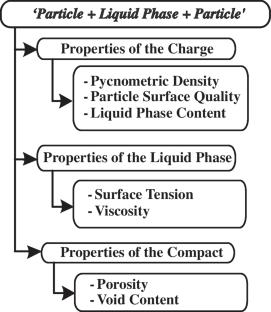The development of analytical methods for predicting the strength characteristics of pellets produced by the compaction of fine-grained materials remains a significant and relevant area. To advance this area, the mechanisms of phase interactions in bulk media were analyzed. The analysis was then used to develop local models of adhesion processes for two basic particle interaction schemes: ‘particle + particle’ and ‘particle + liquid phase + particle’. For each local model, the types, nature, and combination of adhesion processes that occurred simultaneously were theoretically established, and the factors and indicators that determined the occurrence and intensity of adhesive bonding were justified. The experimental studies conducted in the laboratory premises of the Nekrasov Iron and Steel Institute of the National Academy of Sciences of Ukraine were analyzed to evaluate the nature and extent of influence exerted by the selected factors, determining the adhesion processes, on changes in the strength characteristics of compacts. Considering the results obtained and the analytical dependences established for the ‘particle + particle’ interaction scheme, a method for predicting the strength characteristics of pellets produced from fine-grained materials with zero moisture was developed. This paper justifies the methodological conditions for experiments intended to create strong bonds within the compacts under the ‘particle + liquid phase + particle’ interaction scheme, taking into account the mechanical, physical, and physicochemical interaction processes between individual particles of the pelletized material and between the charge components (liquid phase). A generalized analysis of the experimental findings was carried out to estimate the range of potential adhesion processes inherent in the ‘particle + liquid phase + particle’ interaction scheme, identify their manifestation, study the nature of their interaction, and evaluate the effect of introducing the liquid phase into the pelletized charge, considering the applied compaction pressures. The collected array of experimental data will enable a detailed cross-correlation analysis to determine the influence of various factors on the adhesion processes and the formation of strong bonds within the compacts. The analysis will also help establish the dependence of strength characteristics of compacts on integral indicators contributing to the formation of adhesive bonds and describe the dependence by analytical methods. The results will be used to develop a method to determine the moisture content in the charge required to produce compacts with maximum strength from materials that belong to the first of the four groups of systematization. The classification of materials into specific groups of systematization is determined by their pycnometric density.



